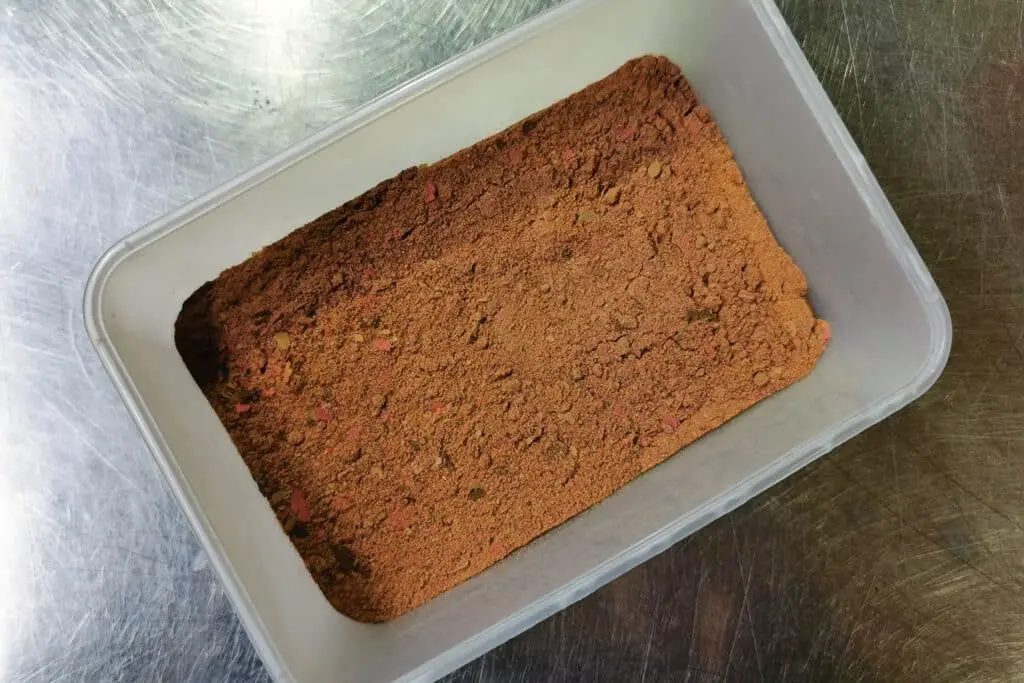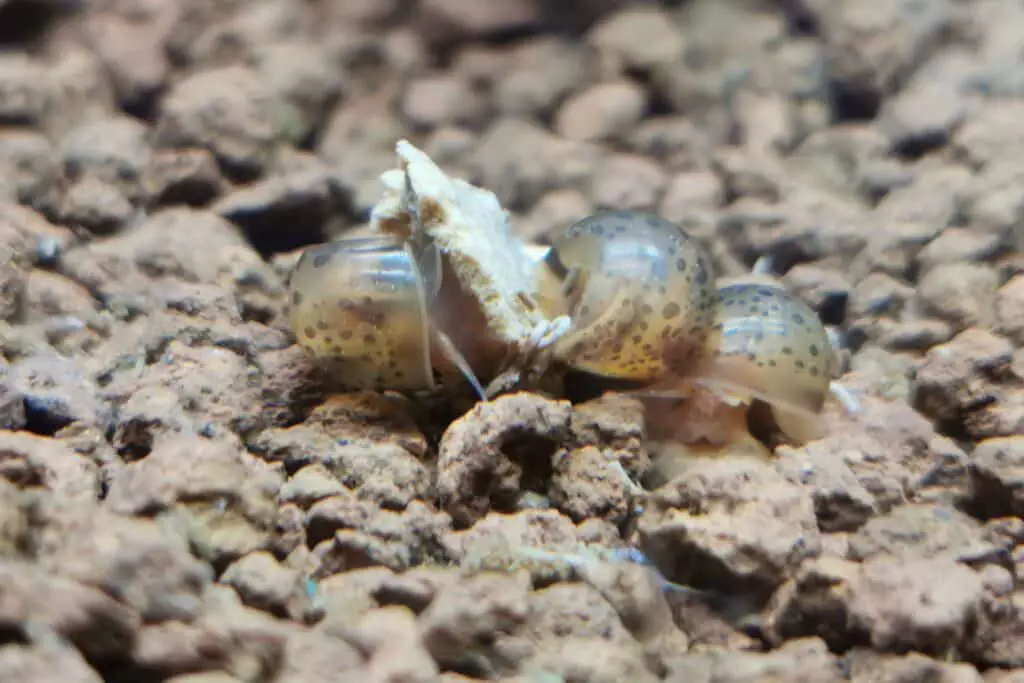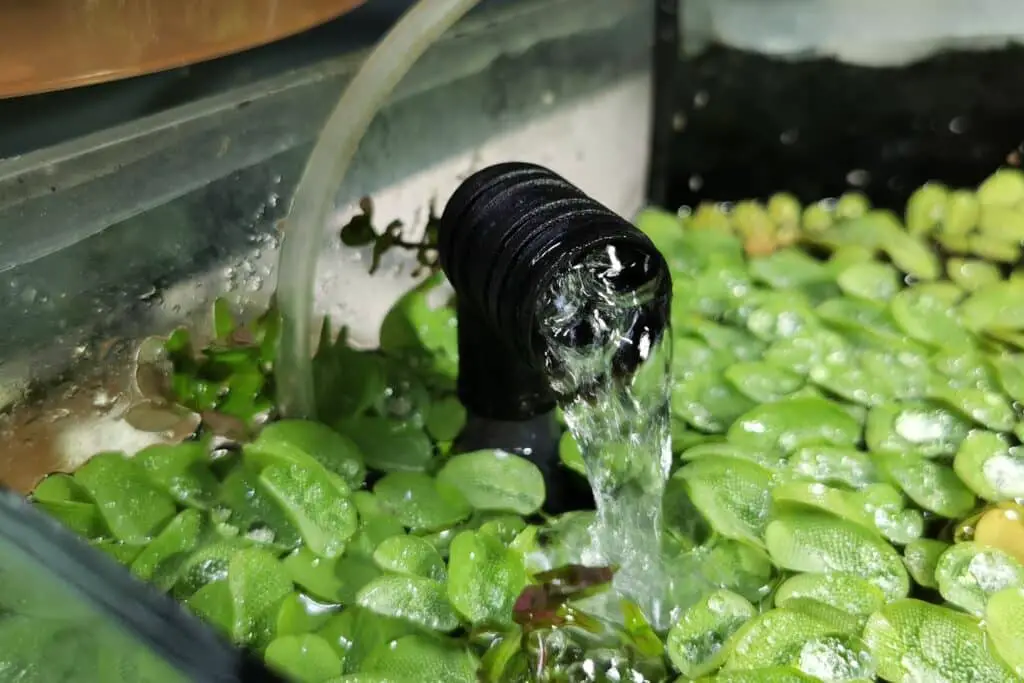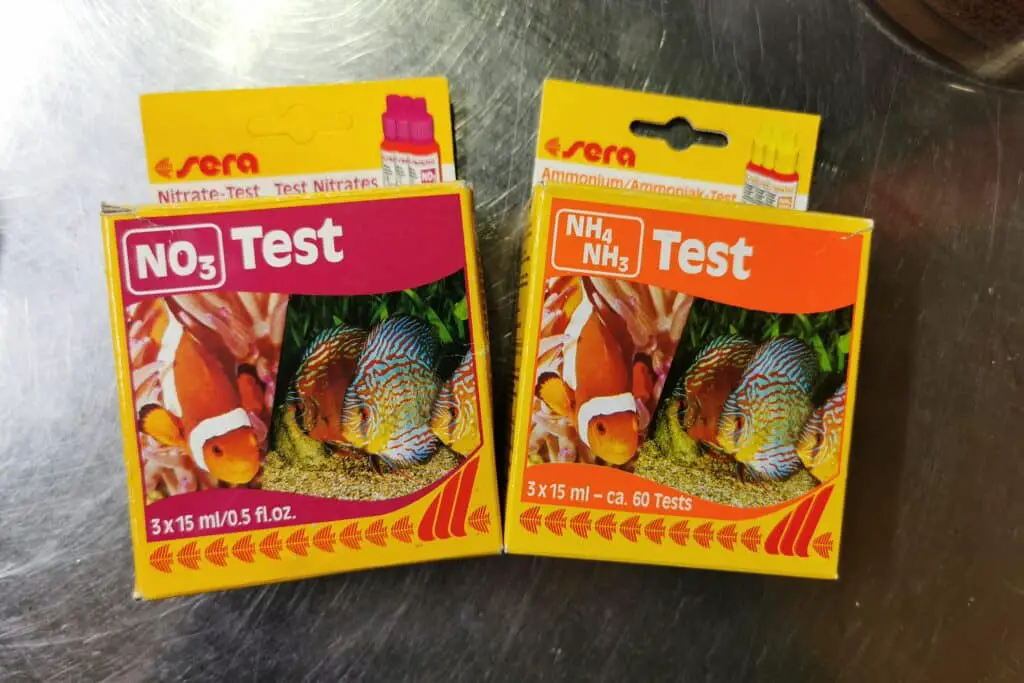Aquariums are a wonderful way to bring a bit of nature into your home, but they require a certain amount of care and maintenance to keep the fish healthy and the water clean. One important aspect of aquarium maintenance is the nitrogen cycle.
The nitrogen cycle is a process by which beneficial bacteria convert harmful waste products into less harmful compounds. In a healthy aquarium, the nitrogen cycle runs continuously, ensuring that the water remains clean and safe for the fish to live in.
However, establishing a healthy nitrogen cycle in a new aquarium can take some time. A fishless cycle is a way to establish the nitrogen cycle in a new aquarium before adding fish or shrimp. This is an important step to ensure the health and safety of the fish. There are several ways to do a fishless cycle, but in this blog post, we’ll focus on one method – ghost feeding.
Ghost feeding is a technique used to provide ammonia to an aquarium to start the nitrogen cycle without adding fish. The idea is to simulate the waste that fish produce by adding food to the aquarium and letting it decompose.
This creates the ammonia necessary to start the nitrogen cycle. The advantage of ghost feeding over other methods is that it avoids the potential risks associated with adding live fish. Ghost feeding also allows for greater control over the amount of food added to the aquarium, which can help to ensure that the nitrogen cycle is established more quickly and efficiently.
In this blog post, we’ll explain the process of setting up a fishless cycle using ghost feeding. We’ll discuss the nitrogen cycle, the importance of testing the water, and how to prepare your aquarium for the fishless cycle.
We’ll also provide step-by-step instructions for ghost feeding, as well as tips for maintaining a healthy aquarium after the cycle is complete. Finally, we’ll discuss the advantages and disadvantages of ghost feeding, so you can make an informed decision about whether it’s the right method for you.
The Nitrogen Cycle
The nitrogen cycle is a natural process by which waste products are broken down in an aquarium. In a healthy aquarium, the nitrogen cycle runs continuously, converting harmful ammonia to less harmful compounds such as nitrite and then to nitrate. Understanding the nitrogen cycle is important when establishing a fishless cycle using ghost feeding.
The nitrogen cycle can be broken down into three stages: ammonia, nitrite, and nitrate. Ammonia is a toxic waste product that is produced by fish waste, uneaten food, and other organic matter in the aquarium.
In a healthy aquarium, beneficial bacteria convert ammonia to nitrite, which is also toxic to fish. Another type of beneficial bacteria then converts nitrite to nitrate, which is less toxic and can be safely removed from the aquarium through water changes.
Beneficial bacteria are essential to the nitrogen cycle. These bacteria are found naturally in the aquarium, but their population needs to grow in order to effectively break down the waste in the aquarium. This is why it’s important to establish a healthy nitrogen cycle before adding fish to the aquarium.
Testing the water is an important part of the fishless cycle. Regular testing of ammonia, nitrite, and nitrate levels helps to monitor the progress of the cycle and ensures that the levels of these compounds stay within safe limits for the fish.
Test kits are readily available at most pet stores and can provide accurate and reliable results. Keeping a log of the water test results can help you to track the progress of the cycle and make any necessary adjustments to ensure that the nitrogen cycle is established properly.
Understanding the nitrogen cycle is crucial to establishing a healthy aquarium. The nitrogen cycle is a natural process that breaks down waste products in the aquarium into less harmful compounds. Beneficial bacteria play a crucial role in the nitrogen cycle, and regular testing of ammonia, nitrite, and nitrate levels is important to ensure that the cycle is progressing properly.

Preparing Your Aquarium
Preparing your aquarium for a fishless cycle using ghost feeding involves several key steps to ensure that the aquarium is set up for success.
- Choose the right substrate, decor, and plants – Choosing the right substrate, decor, and plants can help to create a healthy environment for the beneficial bacteria that will establish the nitrogen cycle. Gravel or sand can be used as a substrate, and it’s important to choose decor that won’t release any harmful chemicals into the water. Live plants can also help to establish the nitrogen cycle, as they produce oxygen and absorb some of the waste products.
- Set up your filtration system – A filtration system is essential to maintaining a healthy aquarium. It helps to remove waste products and keep the water clean. There are several types of filtration systems available, including hang-on-back filters, canister filters, and sponge filters. It’s important to choose the right type of filter for your aquarium size and make sure that the filter is properly installed and running.
- Install a heater – Most aquariums require a heater to maintain a consistent temperature. The temperature in the aquarium should be kept between 76-82°F (24-28°C)for fish if you plan to keep shrimp you might not even need a heater if the room the shrimp are going to be kept in is above 20c., depending on the type of fish or shrimp you plan to keep. It’s important to choose the right size heater for your aquarium and to monitor the temperature regularly.
- Add dechlorinated water – Before adding the ghost feeding, it’s important to fill the aquarium with dechlorinated water. Chlorine and chloramine can be harmful to the beneficial bacteria that will establish the nitrogen cycle, so it’s important to remove these chemicals before adding any water to the aquarium. Dechlorinated water can be obtained from your local pet store, or you can use a water conditioner to remove chlorine and chloramine from tap water.
Preparing your aquarium for a fishless cycle using ghost feeding involves several important steps. Choosing the right substrate, decor, and plants can help to create a healthy environment for the beneficial bacteria.
Setting up a filtration system and a heater can help to maintain a stable environment for the bacteria to grow. Finally, adding dechlorinated water to the aquarium is important to ensure that the chlorine and chloramine do not harm the beneficial bacteria.
Ghost Feeding
Ghost feeding is a technique used to simulate the waste produced by fish without actually adding any fish to the aquarium. This method involves adding a small amount of fish food to the aquarium and allowing it to decompose, creating the ammonia necessary to start the nitrogen cycle.
to the aquarium and allowing it to decompose, creating the ammonia necessary to start the nitrogen cycle.
- Choose the right type of food – When ghost feeding, it’s important to choose the right type of food. Flakes, pellets, or other types of fish food can be used, but it’s important to choose a high-quality brand that doesn’t contain any harmful additives or preservatives. Some people prefer to use pure ammonia instead of fish food, but this requires more precise measurements and can be more difficult to control.
- Add a small amount of food – When adding the food to the aquarium, it’s important to add only a small amount. Too much food can lead to overfeeding, which can cause harmful bacteria to grow instead of beneficial bacteria. As a general rule of thumb, add enough food to create 4 ppm (parts per million) of ammonia in the water. This can be measured using an ammonia test kit.
- Monitor the ammonia levels – It’s important to monitor the ammonia levels regularly using an ammonia test kit. As the beneficial bacteria grow, they will convert the ammonia to nitrite, so the ammonia levels should begin to drop after a few days. It’s important to add more food or ammonia as needed to maintain the ammonia levels around 4 ppm.
- Wait for the cycle to complete – The ghost feeding process can take several weeks to complete, depending on the size of the aquarium and the efficiency of the filtration system. During this time, it’s important to continue testing the water regularly and adding more food or ammonia as needed. Once the nitrite levels begin to drop and the nitrate levels begin to rise, the cycle is almost complete.
Ghost feeding is a technique used to start the nitrogen cycle in a new aquarium without adding any fish or fish food. Choosing the right type of food, adding a small amount of food, monitoring the ammonia levels, and waiting for the cycle to complete are all important steps in the ghost feeding process. Regular testing of the water and patience are key to ensuring that the nitrogen cycle is established properly before adding any fish to the aquarium.

Testing Your Water
Testing your water is an important part of the fishless cycle by ghost feeding. Regular testing helps to monitor the progress of the cycle and ensures that the levels of ammonia, nitrite, and nitrate stay within safe limits for the fish.
- Ammonia testing – Testing the ammonia levels is important to monitor the progress of the ghost feeding process. Ammonia test kits are readily available at most pet stores and can provide accurate and reliable results. Test the ammonia levels every day at the beginning of the cycle, and then reduce the frequency of testing as the cycle progresses.
- Nitrite testing – Once the ammonia levels begin to drop, nitrite levels will begin to rise. Nitrite is also toxic to fish, so it’s important to monitor the nitrite levels regularly using a nitrite test
 kit. Nitrite testing should be done every day until the nitrite levels begin to drop and the nitrate levels begin to rise.
kit. Nitrite testing should be done every day until the nitrite levels begin to drop and the nitrate levels begin to rise. - Nitrate testing – Nitrate is the final product of the nitrogen cycle, and it’s less harmful to fish than ammonia and nitrite. However, high levels of nitrate can still be harmful to fish, so it’s important to monitor the nitrate levels regularly using a nitrate test kit. Nitrate testing should be done once a week after the cycle is established.
- Keeping a log – Keeping a log of your water test results can help you to track the progress of the cycle and make any necessary adjustments to ensure that the nitrogen cycle is established properly. This can also be helpful if you ever need to troubleshoot any issues with your aquarium in the future.
Waiting for the Cycle to Complete
Waiting for the cycle to complete is an important part of the fishless cycle by ghost feeding. The cycle can take several weeks to complete, depending on the size of the aquarium and the efficiency of the filtration system. During this time, it’s important to be patient and not rush the process.
- Be patient – The process of establishing the nitrogen cycle takes time, and it’s important to be patient. Rushing the process can lead to problems with the aquarium, such as harmful bacteria growing instead of beneficial bacteria. The amount of time it takes to complete the cycle will depend on the size of the aquarium, the efficiency of the filtration system, and the amount of food or ammonia added to the aquarium.
- Watch for signs of progress – As the cycle progresses, there will be visible signs of progress. The water may become cloudy at first, but it should begin to clear up as the bacteria establish themselves. The ammonia levels will begin to drop, and the nitrite levels will begin to rise. Once the nitrite levels begin to drop and the nitrate levels begin to rise, the cycle is almost complete.
- Keep testing the water – Testing the water regularly is important throughout the cycle to ensure that the levels of ammonia, nitrite, and nitrate stay within safe limits for the fish. Regular testing can also help you to track the progress of the cycle and make any necessary adjustments.
- Do a partial water change
 – Once the cycle is complete, it’s important to do a partial water change to lower the nitrate levels. Nitrate is less harmful to fish than ammonia and nitrite, but high levels can still be harmful. A partial water change can help to lower the nitrate levels and maintain a healthy environment for the fish.
– Once the cycle is complete, it’s important to do a partial water change to lower the nitrate levels. Nitrate is less harmful to fish than ammonia and nitrite, but high levels can still be harmful. A partial water change can help to lower the nitrate levels and maintain a healthy environment for the fish.

Advantages and Disadvantages of Ghost Feeding
Ghost feeding is just one method of establishing a fishless cycle, and it has its own set of advantages and disadvantages. Here are some of the main pros and cons of using ghost feeding:
Advantages:
- No need for live fish – Ghost feeding allows you to establish the nitrogen cycle without adding any live fish or fish food to the aquarium. This can help to reduce the risk of disease and overfeeding.
- Greater control over the amount of ammonia added – With ghost feeding, you have greater control over the amount of ammonia added to the aquarium. This can help to ensure that the nitrogen cycle is established more quickly and efficiently.
- Cost-effective – Ghost feeding is a cost-effective method of establishing the nitrogen cycle, as it doesn’t require any live fish.
Disadvantages:
- Longer cycle time – Ghost feeding can take longer to establish the nitrogen cycle than other methods, such as adding pure ammonia. This can be a disadvantage if you’re in a hurry to add fish or shrimp to the aquarium.
- More challenging to monitor – Ghost feeding can be more challenging to monitor than other methods. Because you’re relying on the decomposition of fish food to create the ammonia, it can be difficult to know exactly how much ammonia is being produced at any given time.
- Risk of overfeeding – Overfeeding can lead to harmful bacteria growing instead of beneficial bacteria, which can lead to problems with the aquarium. It’s important to add only a small amount of food and to monitor the ammonia levels regularly to avoid overfeeding.

Conclusion
Ghost feeding is reliable for establishing a fishless cycle in your aquarium. This approach is cost-effective and ensures the proper establishment of the nitrogen cycle. This is crucial for creating a healthy environment for your aquatic pets.
If you ever need help, don’t hesitate to reach out. You can find us on Facebook at Aquarium Shrimp Keeping if you can’t reach me here. Remember, we’re here to help you on your journey. Happy Shrimp Keeping!
FAQ
Q. How do you cycle a tank with ghost feeding?
A. Ghost feeding is a method used to cycle a tank without fish. It involves adding a small amount of fish food to the tank, which decomposes and releases ammonia. This starts the nitrogen cycle in the tank. Regular monitoring of ammonia, nitrite, and nitrate levels is necessary during this process.
Q. How often should I Ghost feed?
A. The frequency of ghost feeding depends on the ammonia levels in your tank. You should aim to maintain an ammonia level of about 3-4 ppm. If the ammonia level drops below this, you should add more food.
Q. Can you cycle a tank without fish food?
A. Yes, you can cycle a tank without fish food by using pure ammonia or a bottled bacteria product. These methods can be more precise and faster, but they require careful monitoring and control of ammonia levels.
Q. Will dead fish help cycle tank?
A. Yes, a dead fish can help cycle a tank as it decomposes and releases ammonia, which starts the nitrogen cycle. However, this method can be unpredictable and potentially unsanitary, so it’s generally recommended to use other methods like ghost feeding or adding pure ammonia.
Q. What is the fastest way to cycle a new tank?
A. The fastest way to cycle a new tank is to use a filter or filter media from an established or cycled tank. This introduces beneficial bacteria to the new tank, which can significantly speed up the cycling process.
Q. How do I know if my tank is cycled?
A. You can determine if your tank is cycled by testing the water for ammonia, nitrite, and nitrate levels. If the ammonia and nitrite levels are zero and nitrate levels are less than 30 ppm, then the tank is likely cycled.
Q. How do you use ghost feed?
A. To use ghost feeding, you add a small amount of fish food to the tank. This food decomposes and releases ammonia, which starts the nitrogen cycle. You should monitor the ammonia, nitrite, and nitrate levels regularly and continue ghost feeding until the tank is cycled.
Q. Does fish food create ammonia?
A. Yes, fish food can create ammonia as it decomposes. This is why it’s used in ghost feeding to start the nitrogen cycle in a fish tank.
